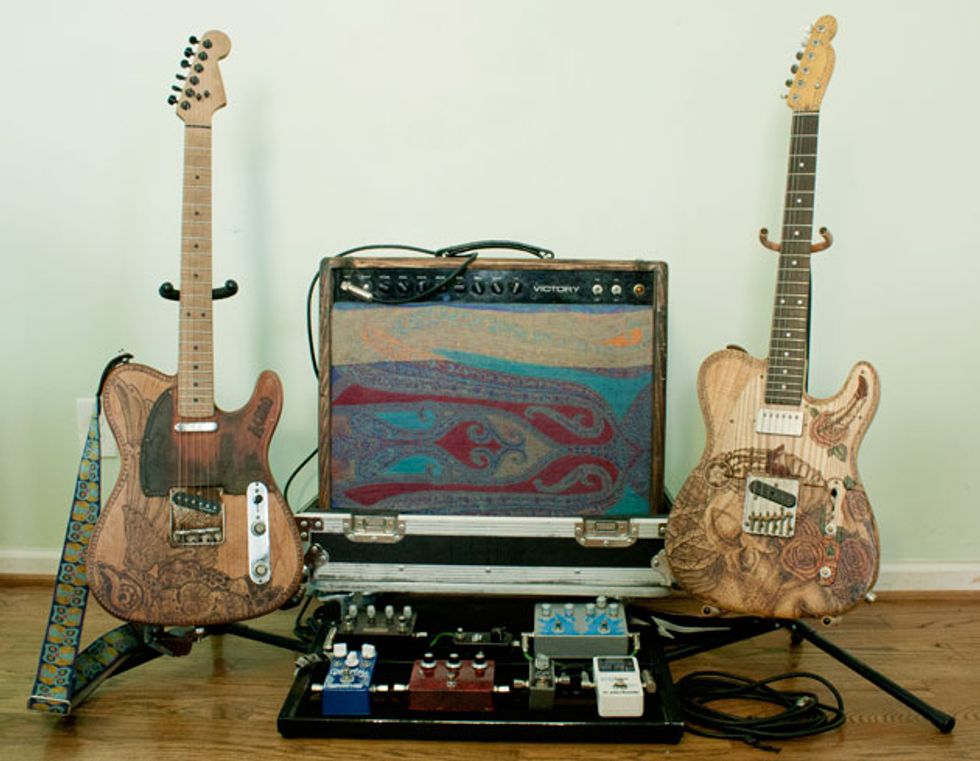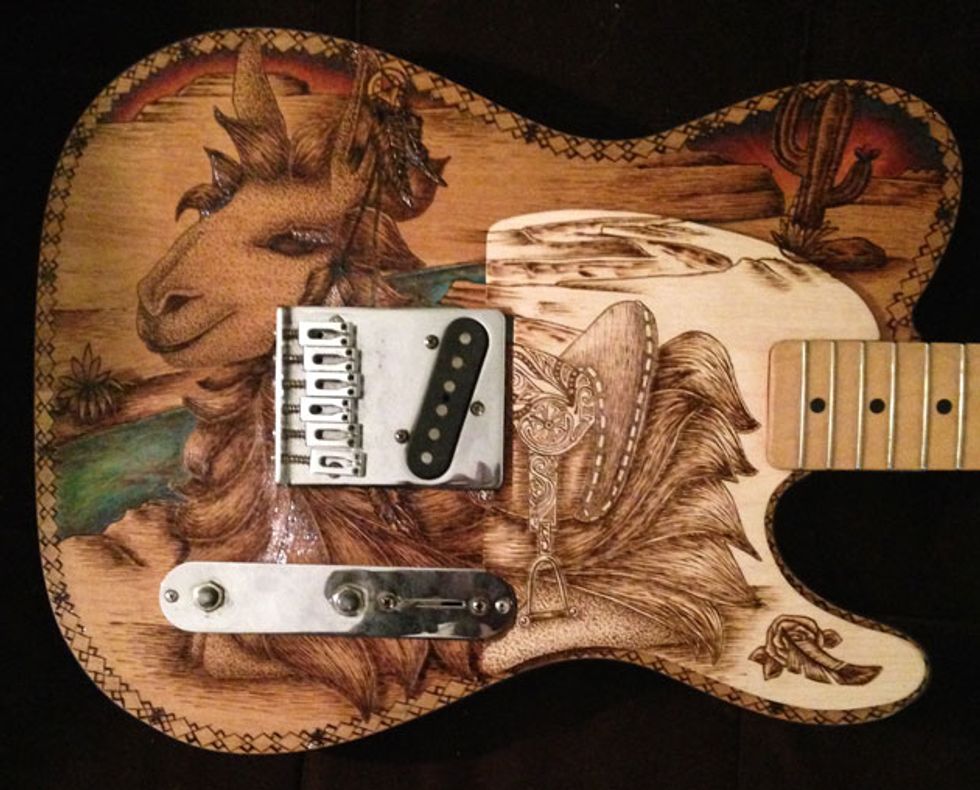There’s no shortage of artists having a go at classic Americana, roots, and country music, but few do as impressive a job of revitalizing the tried-and-true as Banditos. Now based in Nashville, the group emerged in Birmingham, Alabama, and their eponymous debut LP is a soulful celebration of all that is great about traditional country music served up with a rock ’n’ roll twist. While successfully avoiding the Dixie-rock clichés many young country acts rely on, Banditos sound simultaneously familiar and fresh. Punctuated by fiery Tele licks and tasteful flourishes of lap steel, their music also boasts sophisticated arrangements by lead guitarist Jeffery Salter, who studied jazz and classical guitar in college.
When Salter isn’t on the road with Banditos, he’s busy building unique, Fender-inspired guitars under the name Pyrose Wood Works. His instruments feature premium parts and killer wood-burned decorations, and he plays them exclusively—both in the studio and on tour.
PG spoke with the guitarist/luthier about his journey from jazz to country music, the band’s from-the-hip writing and recording process, and the rare gem of an amplifier that he swears by.
private lessons on it.”
How did you get into country and roots music?
My parents’ good friend taught me how to play guitar when I was a kid. He was an older blues guy—a fingerpicker. He was a random player who couldn’t seem to finish a song, but when you could get him to settle down into something he was really good. When I was 13 or 14 years old, he loaded me up with a bunch of albums—Tom Waits, John Hammond Jr., some Chet Atkins, and some Mississippi John Hurt. That’s what hit me the hardest, I think—the Mississippi John Hurt stuff.
That was the start of me searching through all this music. I didn’t even really know I was playing country music until much later. We were playing in thrash-metal and punk bands, and I’d go home and practice Chet Atkins tunes because they were fun. Roy Buchanan is a huge influence, too. His guitar playing is so vocal—the instrument just cried when he played.
What happened after that?
Fingerpicking just came naturally, so I ended up going to school for classical guitar because it made sense—I didn’t really aspire to be a classical guitarist or anything.
How far did you take your formal music education?
In school I was primarily a classical guitar player, but they had the option for us to study jazz too, so I took lessons from Carlos Pino—an amazing jazz guitarist in Birmingham. I took about four years of private lessons from him at school.
Jeffery Salter's Gear
Guitars
Two Pyrose Wood Works T-style electrics
Amps
Heritage Victory 1x12 22-watt combo
Effects
Klon clone
Wampler Paisley Drive
Empress Vintage Modified Superdelay
Blackout Effectors Crystal Dagger
Pigtronix Rototron
Xotic Effects EP Booster
Lovepedal Babyface Tremolo
Strings and Picks
DR Pure Blues (.010–.046)
GHS Boomers (.010-.046)
Dunlop Jazz III
So you began as a fingerstyle guitarist. Do you play with a flatpick too?
I do now. I didn’t for years, but as time went on with this band, I found it was hard to fingerpick lead guitar. I wasn’t a lead guitar player when we started this whole thing. Early on when we began this band, I was studying jazz guitar and trying to figure out how to play leads. My bandmates were asking me to play leads too, so it was a matter of finally putting it all together. I slowly started learning how to hybrid pick, which has become a necessity for our music.
Does your jazz background inform your writing with Banditos?
Oh yeah, absolutely! Even if it doesn’t always come through in the playing, I’m a total theory nerd. I love music theory and I used to teach private lessons on it. I can analyze and tell you about jazz guitar all day long—even if I can’t necessarily play it all. And I like arranging music. Some of the guys in the band bring me random tunes and melodies they come up with, and I’ll take those elements and try to make some sense of it.
That explains a lot. Much of the album sounds deceptively simple, yet it contains some complex arrangements—especially in the guitar parts.
There are a million songs out there that have just two or three chords, but you have to have something that makes the music stick.
There are moments on the album where you step out and reveal some serious lead chops, but overall the guitar is pretty restrained. Do you deliberately avoid overplaying?
Honestly, none of it was planned at all. Everything we do just morphs over time on the road and what happens, happens. I don’t spend too much time writing the parts, but instead I come up with a skeleton structure and just let them evolve naturally. I don’t necessarily even think of guitar parts until we hit the studio and I’ll play stuff I’ve been doing on the road for a while. And if it doesn’t work, I’ll think, “Well, shit. I guess I shouldn’t have been playing that for the last couple of years!”
Flanked by his handmade Pyrose Wood Works electrics is Salter’s treasured Heritage Victory 1x12 combo. Built by Paul Cochrane of Timmy pedals fame, and customized with a Pyrose cab and grille cloth, the amp blends characteristics of a Fender Deluxe and Vox AC50.
Did you cut the new album live or did you track the parts individually?
We did it live, probably 95 percent of the way through. We recorded the album at the Bomb Shelter in Nashville. We actually started the album about two years ago and recorded for about four days. We had some friends come in and do organ overdubs and stuff like that, but for the most part, it was all done live. Then recently we went back into the studio for another week. We took out half of the original album, recorded another side to replace it with, and also fixed a bunch of stuff we didn’t love. So we got a chance to go in and really make the album right before putting it out.
What didn’t you love about some of that original material?
While we’ve been at this for almost five years now, we’d only ever done home recordings and demos—we hadn’t released anything in an official capacity. What we had was an accumulation of several things: Songs we’d just written when we went into the studio two years ago, as well as tunes that were about three years old at the time we recorded them. So when we came back to finish the album two years later, some of the songs were just too old—we wanted to get new stuff on there we felt better about. As you can imagine, we’d come quite a bit further as a band, so it was nice to be able to come back and take stuff out and put stuff in that we really liked.
Describe the gear you used on the album.
Pretty much my touring rig. The guitars are actually built by my girlfriend and me in Nashville. They’re like traditional, ’50s-style Telecasters, but with her artwork applied to them. A few years ago I got into putting together partscasters and doing guitar-tech work, and it’s been a fun little hobby. But my girlfriend, Katie DiGrappa, is an incredible artist, and she’s honed her woodburning skills to create the designs featured on our guitars. So when we’re off the road, that’s what we do. We just made two guitars for a customer in Florida, a pair of T-styles made completely out of maple that our banjo player’s cousin harvested from his Birmingham backyard. The guitars were heavy, but they were awesome. We’ve also done guitars for other artists, like the band Clear Plastic Masks.
On the album I mostly played one of the guitars I built—a standard, ’50s Broadcaster-style guitar with Kinman Broadcaster pickups, Emerson Custom wiring, a 4-way switch, and a treble-bleed mod. I plugged it into my Heritage amp, which was built in Nashville by Paul Cochrane, who also makes the Timmy pedals. I wish Paul and Heritage would build amps again—they’re amazing.
Pyrose Wood Works’ Katie DiGrappa decorates the raw bodies with intricate woodburned designs, and Salter assembles the instruments from carefully selected parts.
What model Heritage is that?
It’s called the Victory, which is basically Paul’s take on a Fender Deluxe Reverb. From what I’ve read, it has the front end of a Deluxe and the back end of a vintage Vox AC50. It has great clean headroom, but it also breaks up a lot better than many Fender-style amps. And the reverb is fantastic. There’s a dwell and a mix control, so you can dial in the length of the reverb tail and then back off on the mix, so the sound doesn’t get too washed out when you turn up. It’s really good and punchy.
Are you into pedals?
I’ve always been a pedal nut. Even if they don’t do much, I love them. I recently got a Klon clone from a guy in Nashville, and now I’ve gotten rid of almost everything but that. I also use an Empress Vintage Modified Superdelay. It emulates a tape echo, and I use it for almost all my delay stuff. I also played a vintage Leslie cabinet on a lot of the record—it’s all over “Golden Grease” and “Old Ways”—and I just picked up a Pigtronix Rototron to try to get that sound onstage. I’ve been after that particular sound for a couple of years. I’ve gone through just about every phaser and vibe pedal out there, and nothing has ever quite hit it, but this pedal is actually pretty cool. Once we get a big enough trailer, I’ll just find a real Leslie cab, but until then, the Rototron works. It’s really fun—almost like a dual phaser that’s tuned more like a Leslie. I also swear by the Xotic EP Booster. I’ve had Xotic pedals forever and tried everything in their line, and this one is the be-all and end-all for me.
YouTube It
Banditos play “Golden Grease”—a track from their self-titled debut album—at Licha’s Cantina in Austin. Dig the rave-up that hits at 4:40.
It’s difficult to say something new and fresh in roots music—or any genre that relies on a certain degree of authenticity to work—but you guys have managed to create a unique sound without sacrificing the retro vibe.
That’s definitely something we keep in mind when we approach a song. There are a lot of great bands out there, but many of them try to do the Merle Haggard or Willie Nelson thing. It’s hard to do anything remotely original in any genre these days, but it’s not cool to rip anybody off, so we attempt to add something else to the equation. Each of us brings something different to the band, and every song on the album shines the spotlight on our individual players. That really seems to work out for us.
















![Rig Rundown: Russian Circles’ Mike Sullivan [2025]](https://www.premierguitar.com/media-library/youtube.jpg?id=62303631&width=1245&height=700&quality=70&coordinates=0%2C0%2C0%2C0)
















![Rig Rundown: AFI [2025]](https://www.premierguitar.com/media-library/youtube.jpg?id=62064741&width=1245&height=700&quality=70&coordinates=0%2C0%2C0%2C0)




















 Zach loves his Sovtek Mig 60 head, which he plays through a cab he built himself at a pipe-organ shop in Denver. Every glue joint is lined with thin leather for maximum air tightness, and it’s stocked with Celestion G12M Greenback speakers.
Zach loves his Sovtek Mig 60 head, which he plays through a cab he built himself at a pipe-organ shop in Denver. Every glue joint is lined with thin leather for maximum air tightness, and it’s stocked with Celestion G12M Greenback speakers.






